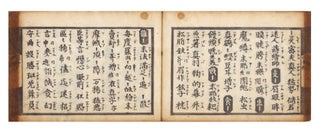Metal or Wooden Movable Type?
T’AEHAK KAENGJAE CH’UK or Taehak gaengjae chuk 太學賡載軸 [Scroll with the King’s Interview with His Officials at Sŏnggyun’gwan].
Ten columns per page, 21 characters per column. Two sizes of type. 38 folding leaves. Large 8vo (321 x 200 mm.), orig. brown patterned wrappers, new stitching. [Seoul]: Pich’ŏndang 丕闡堂 Building, Sŏnggyun’gwan [today’s Sungkyunkwan University], 1872.
First edition and very rare; WorldCat lists only the Berkeley copy. “Scroll” is clearly used here as a figure of speech, as this is a codex-style book, printed using movable (metal or wooden?) type in 1872. Sungkyunkwan, established in 1398, was the highest educational institution in Chosŏn Korea. It is now the sight of an eponymous university. The location of the printing of this book was Pich’ŏndang, a building at Sungkyunkwan. In the interview described in the title, the young king Kojong (1852-1919, ruled 1864-1907) was querying his subjects on Confucius’s Analects.
Different sources give somewhat different information on the set of type used. The online catalogue for Changsŏgak (Jangseogak), which has a copy, says that wooden type was used, whereas the printed catalogue for Korean books at UC Berkeley (see reference at bottom) says that it is newly cast metal type (but the WorldCat entry for this copy states that wooden movable type was used). To our eyes, the type appears to be metal due to the extreme fineness and clarity of the characters.
All sources agree, however, that the model for the type is the so-called chŏngnija type, first cast under Chŏngjo in 1796. The name of the type is a reference to one of the first books printed with it: Chŏngni ŭigwe 整理儀軌 [Arranged Royal Protocols], documenting Chŏngjo’s visit to his father’s tomb. The models for the character shapes used in that set of type were the characters in Kangxi zidian 康熙字典 [Character Standard of the Reign of Secure Peace], a landmark Chinese dictionary published at the Qing court in 1716. The original set of type was destroyed in 1857, so this book was printed with the new set.
At the back of the volume is a manuscript colophon that we have had great difficulty deciphering, even with the help of a knowledgeable friend. The colophon recounts events in the “eleventh month of the sinmi year,” corresponding to 12 December 12 1871 to 9 January 1872, and then early in the second month of the following year, meaning March 1872. At this time, the author of the colophon was present as the king ascended to the throne at Myŏngnyundang 明倫堂 [Hall for Elucidating the Moral Order] at Sŏnggyun’gwan, upon which the king composed a quatrain of classical Chinese verse. The text appears to continue to describe the events of that day, and then mentions that a book, titled kaengjaech’uk — probably the present book — was printed and should be distributed to the eight provinces. We cannot say anything for certain about this colophon since we are unable to read much of it, but it seems possible that it was written close to the date of printing by someone who was present on the day the exchange between king Kojong and the officials took place.
Fine and fresh copy.
References
Kim Hŭnggyu et al. Pŏk’ŭlli Taehak Tongasia tosŏgwan sujip Han’guk kojŏnjŏk mongnok. Seoul: Korea University Research Institute of Korean Studies, 2009.
Price: $9,500.00
Item ID: 8941

![Item ID: 8941 T’AEHAK KAENGJAE CH’UK or Taehak gaengjae chuk 太學賡載軸 [Scroll with the King’s Interview with His Officials at Sŏnggyun’gwan].](https://jonathanahill.cdn.bibliopolis.com/pictures/8941.jpg?width=768&height=1000&fit=bounds&auto=webp&v=1680727542)
![T’AEHAK KAENGJAE CH’UK or Taehak gaengjae chuk 太學賡載軸 [Scroll with the King’s Interview with His Officials at Sŏnggyun’gwan].](https://jonathanahill.cdn.bibliopolis.com/pictures/8941_2.jpg?width=320&height=427&fit=bounds&auto=webp&v=1680727542)
![Shozaishu 匠材集 [Dictionary of Renga Poetry [or] Collection of Building Materials. Joha 里村紹巴 SATOMURA.](https://jonathanahill.cdn.bibliopolis.com/pictures/6999.jpg?width=320&height=427&fit=bounds&auto=webp&v=1588723281)

![Pak Ssi ch’irhyŏn kŏŭi rok [or] Pak Ssi chirhyeon geoeui rok. Chae-hwan PAK, Je-hwan or PAK.](https://jonathanahill.cdn.bibliopolis.com/pictures/9425.jpg?width=320&height=427&fit=bounds&auto=webp&v=1694206663)
![Seiko] Kaikoku heidan [Military Defense of a Maritime Nation. Shihei HAYASHI.](https://jonathanahill.cdn.bibliopolis.com/pictures/8650.jpg?width=320&height=427&fit=bounds&auto=webp&v=1671567003)